This month we offer our thanks and congratulations to our Treasurer, Alison Foster. Firstly for helping to organise a most successful conference 'Medicinal Plants: Crop to cure?'. This well-attended meeting provoked plenty of discussion and hopefully longer-term contact between academic researchers and members of the companies that extract the active ingredients from medicinal plants and commercialise products. A full report on this will appear next month. Secondly we congratulate Alison who, after leaving a career in the pharmaceutical industry and retraining as a horticulturist, has been appointed as senior curator at the University of Oxford Botanic Garden and Harcourt Arboretum.
And do not forget our forthcoming event: Biofortified and Functional Food: A Healthy Future? on 19 May 2011.
Editor
Horticulture in adversity
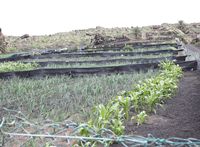
Why then does Lanzarote, the most northerly of the main Canary Islands, present such a challenging environment for any form of agriculture? Partly because it lies closest to the burning heat of the Sahara but also it is subjected to the dry heat of the north east trade winds and, having the lowest altitude, attracts only minimal rainfall (110mm per annum). Nevertheless, up until the early eighteenth century, a plain on the west of the island provided a fertile area for food and wine production. This idyll ended in 1730 when a new volcano, Timanfaya, erupted in the middle of the plain and covered around one third of the island, including most of the fertile land and its villages, with lava: lava that to this day supports little more than a sparse growth of lichen and scattered Euphorbia.
Faced with this, the island's farmers have resorted to water harvesting to provide water for themselves and their animals; camels are the main draft animals while goats the main livestock. They have also adopted their own growing technique called 'enarenado'. This relies on the particular properties of the fine black lapilli that have been ejected by some of the 300 odd volcanoes that form the island. These angular lapilli, called 'picon' by the islanders, are between 2-4mm and act as a porous mulch, drawing moisture from the air by night, releasing it into the ground and preventing evaporation by day. The black colour causes the surface to cool rapidly at night bringing the relatively moist air blowing from the Atlantic Ocean to its condensation point. The 'dew' that forms is absorbed by the lapilli and percolates down to the soil below. By day the black surface absorbs heat equally efficiently but the layer of mulch protects the underlying soil and minimises water loss through evaporation. While the black mulch helps reduce evaporation from the soil the crops would still be exposed to the ever-present drying winds.
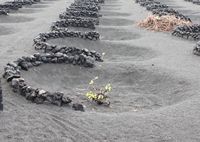
By exploiting the limited assets of the island the islanders have devised a system of growing that counteracts the extreme problems they face and enabled them to develop an admittedly limited growing industry.
Plant of the Month
Euphorbia characias subsp. wulfenii, Euphorbiaceae
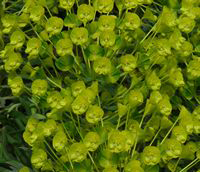
Euphorbia is possibly the largest angiosperm genus with approximately 2000 species. Many people think first of the annual weed euphorbias such as sun spurge and petty spurge (of which more later) but there are many hardy types with horticultural merit. We should also not forget the tender, succulent euphorbias, which have evolved to have the same adaptations to a low water environment as the cacti.
Gracing many a border is this month's plant, which is in full flower at the moment. Euphorbia characias (picture right) grows wild across the Mediterranean basin from Portugal to Turkey and is an extremely variable species. Growing at the western end of the Mediterranean with dark red/purple nectar glands this plant is known as Euphorbia characias subsp. characias but by the far eastern end of the Mediterranean the nectar glands are typically yellow and horned. These plants were originally named as a separate species – Euphorbia wulfenii but are now considered to a subspecies and are known as Euphorbia characias subsp. wulfenii.
Euphorbia flowers sit within a structure called the cyathium (from the Greek word for a cup or ladle). Around the rim of the cyathium is a ring of swollen appendages which as glands that secrete nectar in order to attract and reward pollinators. It is these glands that vary so greatly in this euphorbia species.
These plants are extremely hardy and have come through the past two winters well. They certainly make excellent additions to the garden. In addition to the natural variations in this species, many cultivars have been developed over the years. 54 are currently listed in the RHS plant finder although only 35 are listed as currently available. Are you growing any of them?
Alison Foster
Oxford Botanic Garden
Medicinal Plant of the Month
Euphorbia peplus
, Euphorbiaceae
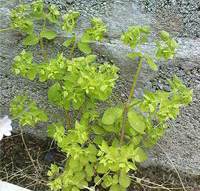
Alison Foster
Oxford Botanic Garden
Horticulture Industry News
For the very latest horticultural news follow us on Facebook and or
Twitter.
Forestry Commission appoints Dr John Morgan as head of plant health service
Commenting on the new appointment, Forestry Commission director-general Rim Rollinson said: 'I'm delighted that John Morgan has accepted this vitally important role. Pests and diseases pose an increasing threat to Britain's trees and forests, and John brings to the post just the kind of breadth and depth of knowledge, skills and experience that we need to lead our efforts to tackle it.'
Bemisa tabaci identified at border points
The Food & Environment Research Agency (FERA) found this whitefly on plants during the period from mid-February to mid-April. The infestations included Ocimum basilicum (Sweet Basil) imported from the Canaries and found in London; Hibiscus in parcels from the United States detected at the Coventry Parcels Depot; on Hemigraphis colorata (Red Flame Ivy) from Singapore found at Heathrow Airport; on Alternanthera from Singapore identified at Manchester Airport and on Bacopa from Singapore detected at Heathrow Airport.
FERA is currently consulting with growers on the future of the UK's protected zone status against Bemisia tabaci. The UK is one of a limited number of EU member states including Finland, Ireland and Sweden that maintain protected zone status against the pest, which is particularly damaging to salad crops such as cucumber and tomato More
Hydroseeding Trumps 'hand spriggin'!
Donald Trump is on course to fulfill his dream and create the world's greatest golf course in Scotland. Work began last winter when workers moved onto the dunes to begin the first phase of marram grass (Ammophila arenaria) planting. A team of 20 marram grass planters have been working since November on the second phase of hand sprigging thousands of marram plants on the dunes. They are also using rye grass to encourage and support the marram grass. This is being hydro seeded, a system which involves spraying a slurry of seed and mulch to promotes quick germination and reduce soil erosion. The rye grass only lasts for one season but supports the marram during its establishment.
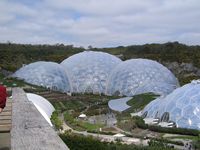
As the Eden Project (Picture right by A1personage) celebrates its first ten years, Head of Horticulture, Don Murray looks to the future and says 'We want to build a canopy walkway and because we have the largest rainforest greenhouse in the world it will ultimately be the largest walkway. We are also hoping to become energy independent by building the first deep heat underground power plant. It's really important because we want to move our nursery and back-up facilities closer to the geothermal site and use it to heat the greenhouses' More
Termites are the arid zones earthworms
CSIRO and University of Sydney scientists have found that allowing ants and termites to flourish increased a wheat crop's yield by more than one third. The study, carried out on a farm in an arid area in Western Australia, showed that ants and termites help to improve water infiltration and soil nitrogen levels. Effectively they play a similar role in dry climates to earthworms in wet climates. The termites and ants create a lot of tunnels under the soil when they forage away from their nests, and this helps water absorption. Bacteria in the termite guts are able to fix significant amounts of nitrogen from the air and some of this nitrogen is transferred to termite tunnels, helping to improve plant growth. More
Phytophthora kernoviae; two Cornish outbreaks during February.
The Food and Environment Research Agency found the pathogen on Vaccinium on 14 and 24 February. This follows further outbreaks of Phytophthora kernoviae discovered on bilberry by Fera earlier in the year. Phytophthora kernoviae is a serious plant pathogen causing diseases of trees and shrubs in UK woodlands, heathlands and managed gardens.
Removing manure solids produces higher yields
The ratio of nitrogen to phosphorus in manure is low in relation to the nutrient needs of most crops. Therefore, crops tend to be overloaded with manure to meet the nitrogen requirement of agricultural crops, but the excess phosphorus from the process can damage the environment. Canadian scientists tested the effectiveness of removing solids from dairy manure by settling the slurry in lagoons in order to improve yield by increasing the nitrogen to phosphorus ratio and reducing the loss of nitrogen by hastening soil infiltration.
The results from the six-year study indicate that using the liquid fraction produced a higher crop yield and 63% more nitrogen recovery than whole manure at equal application rates. More
First practical artificial leaf
The Massachusetts Institute of Technology has unveiled a prototype solar-powered device the size of a playing card that can break water down into hydrogen and oxygen – valuable fuels for producing electricity via fuel cells. This new artificial leaf combines the solar cell and the electrolysis unit into one piece by chemically painting the catalyst onto a solar cell and immersing it in water.
The chemistry is complex but is similar from a systems engineering sense to the manner in which leaves generate energy from sunlight. In plants, the energy of incoming sunlight is first used to produce electrons and positive charges within the leaf. These are then used to split water into oxygen and hydrogen (the latter being trapped as carbohydrates, rather than released into the air). In his artificial leaf, a silicon chip, similar to those used in conventional solar cells, produces electrons and positively charged holes. Then catalysts on the chip use this low-voltage current to produce oxygen and hydrogen – one gas on each side of the chip.
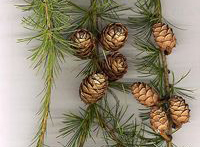
Phytophthora ramorum, which has caused the early felling of about 2 million Japanese larch trees (Larix kaempferi) in the UK, has now been found infecting the European larch (Larix decidua pictured right by MPF) for the first time. The Forestry Commission has confirmed infection by the pathogen in woodland near Lostwithiel, Cornwall in an area with infected Japanese larch trees nearby. Ben Jones, the Forestry Commission's Phytophthora operations manager, said, 'Although it is bad news that this lethal pathogen has proved able to infect yet another tree species, it was not entirely unexpected, given the physiological similarities between European and Japanese larch.'
Watercress by no other name
British watercress is one step closer to becoming the 'champagne of the horticultural world' after farmers passed the first stage of a battle to gain EU protected status for their age-old method of growing in pure, mineral-rich flowing water. A formal application by Defra for Protected Food Name Classification follows two years of preparation and screening. If the cress growers are successful, and their product becomes regarded as a 'traditional speciality', only plants grown in and harvested from flowing water will be able to be sold as 'watercress'.
Curry 'sniffs out' explosives
The curcumin molecule found in the curry spice, turmeric, (see Medicinal Plant of the Month, March Newsletter) is already well-known in medicine for its evident anti-cancer and anti-oxidant properties. Now, research presented at the American Physical Society meeting suggests its light emitting properties could be used to form the basis of a technique to spot explosives like TNT. As it gathers molecules of explosive material in air its light-emitting properties change in ways that can be measured. More
Switched on genes speed evolution
A new plant species, Tragopogon miscellus, appeared in the United States 80 years ago. It came about when two species Tragopogon dubius and Tragopogon pratensis, introduced from Europe, mated to produce a hybrid offspring. These species had mated before in Europe, but the hybrids were never successful. However in America something new happened. The number of chromosomes in the hybrid spontaneously doubled. 'What we found was a surprise,' says Richard Buggs, lead author of the paper and Research Fellow at Queen Mary University of London.
'It's as if hybridisation and chromosome doubling hit a re-set button on gene expression, turning them all on; this could allows subsequent generations to experiment by switching off different genes.' Pamela Soltis, curator at Florida Museum of Natural History said: 'An amazing diversity of gene expression was found among individuals within populations of this young species, even though they originated just 40 generations ago from a single cross. This could be part of the secret of the species' success.'
Quotes of the Month
'Small opportunities are often the beginning of great enterprises'.
Demosthenes (384 BC - 322 BC)
eEvents Calendar
SCI Horticulture Group events are listed here
Other Events of Interest
Advances in Cider and Fruit Wine Technology
7 Apr, Association of applied Biologists
Pershore, UK
Effective control of allergens in food production
7 - 8 Apr, Institute of Food Science & Technology
Chipping Campden, UK
Society of Biology AGM
12 Apr, Society of Biology
London, UK
Flowers & Hortec, Ukraine
12 - 14 Apr, BTO Exhibitions & City of Dreams
Kiev, Ukraine
Trees, People and the Built Environment
13 - 14 Apr, Chartered Institute of Foresters
Birmingham, UK
Landscape
13 - 14 Apr, eFIG
London, UK
Systems Approaches to Crop Improvement
14 - 15 Apr, Association of Applied Biologists
Rothamsted, UK
Vegetation Management
27 - 28 Apr, Association of Applied Biologists
Sheffield, UK
Microbial Horticulture
15 - 19 May, International Society for Horticultural Science
Alnarp, Sweden
Edible Alliaceae
16 - 19 May (Postponement likely), International Society for Horticultural Science
Fukuoka, Japan
Postharvest Unlimited
23 - 26 May, International Society for Horticultural Science
Leavenworth, USA
BIAC AGM
25 May, British Institute of Agricultural Consultants
Tetbury, UK
Greensys 2011
5 - 11 Jun, International Society for Horticultural Science
Halkidiki, Greece
Sustainable Plant Protection Techniques in Fruit Growing
8 - 10 Jun, Centre technique interprofessionnel des fruits et légumes
Bergerac, France
Responsible Peatland Management and Growing Media Production
13 - 17 Jun, International Society for Horticultural Science
Quebec City, Canada
Agricultural Ecology Research: its role in delivering sustainable farm systems
15 - 16 Jun, Association of Applied Biologists
Dundee, Scotland
Modelling in Fruit Research and Orchard Management
19 - 23 Jun, International Society for Horticultural Science
Saint-Jean-sur-Richelieu, Canada
Apricot Breeding and Culture
20 - 24 Jun, International Society for Horticultural Science
Yerevan, Armenia
The Landscaping Show
21 - 22 Jun, British Association of Landscape Industries
Stoneleigh, UK
Augmenting production and utilisation of mango; Biotic and abiotic stresses
21 - 24 Jun, International Society for Horticultural Science
Lucknow, India
Rubus and Ribes Symposium
22 - 26 Jun, International Society for Horticultural Science
Zlatibor, Serbia
Underutilized Plants: Crops for the Future - Beyond Food Security
27 Jun - 1 Jul, International Society for Horticultural Science
Kuala Lumpur, Malaysia
GM Crops: From Basic Research to Application
28 - 29 Jun, Association of Applied Biologists
Harpenden, UK
Turf Show
28 - 29 Jun, Turfgrass, Growers Association
Richmond, UK
National Plant Show
28 - 29 Jun, Horticultural Trades Association
Stoneleigh, UK
Landscape and Urban Horticulture
29 Jun - 3 Jul, International Society for Horticultural Science
Nanjing, China
If you would like to advertise a forthcoming event please contact. zoe.daniel@soci.org
Horticulture Group Contact Details
For submitting ideas or to volunteer to be part of a committee or a group, please contact:
Chairman - Peter Grimbly
Meetings Secretary - Marion Stainton
Minutes Secretary - Margaret Waddy
Newsletter Co-ordinator - Sue Grimbly, E: scihortigroup@btinternet.com
Group Coordinator - Zoe Daniel zoe.daniel@soci.org T: +44 (0)20 7598 1594
